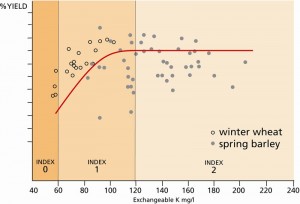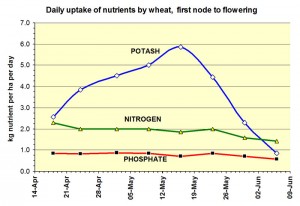Download pdf: Updated cereals recommendations and correction of K deficiency (282.56K)
pdf 282.56K
Updated cereals recommendations and correction of K deficiency
January 2011
The new revised PDA leaflet ‘Potash for Cereals‘ incorporates the changes to the recommendations for cereals in the updated Fertiliser Manual (RB209). For potash these relate to the reduction in the quantity of baled straw which is assumed to be removed per tonne of harvested grain (see PDA leaflet ‘Nutrients in Crop Material‘), now half a tonne of straw per tonne of grain instead of 650 kg, and a small increase in the recommendation for the correction of a low soil K index.
| Table 1: Potash fertiliser recommendation to replace K2O removed in harvested crop, the ‘offtake’. | ||
| Maintenance requirement (kg K2O/ha) | ||
| Grain only – | All cereals | yield t/ha x 5.6 |
| Grain + straw | Winter wheat/barley | yield t/ha x 10.4 |
| Spring wheat/barley | yield t/ha x 11.8 | |
| Oats | yield t/ha x 17.3 | |
| Table 2: Standard RB209 guidance for additional potash applications at K Index 0 or 1. | |||
| Soil fertility adjustment | |||
| Index: (mg K/litre) | 0 (0-60) | 1 (61-120) | 2- (121-180) |
| Adjustment: kg K2O/ha | +60 | +30 | 0 |
The additional applications to low-Index soils are relatively small because this ‘soil improvement’ quantity is normally added to the crop offtake quantity to provide the fertiliser recommendation, and the cost of this combined amount of fertiliser is expected to be paid for by the crop. In judging the profitability of the crop however it is not really fair to expect it to pay for the fertiliser being applied to correct a deficiency in the field. Additional fertiliser applied to improve the fertility of the soil should be seen as a capital maintenance or improvement cost, and should be charged separately – as liming and drainage would be. It should not be a variable cost to be set against the crop which happens to be in the field. The benefit of separating the allocation of the cost of this soil fertility improvement from the cost of the fertiliser which the crop removes – and for which the crop should pay – is that deficient low-Index soils can be corrected much more quickly through larger fertiliser applications without causing the crop being grown to show a loss.

Researchers at Rothamsted found that on their soils it took about 10 kg potash to raise the soil exchangeable potassium concentration by 1 mg/litre. So to raise the soil potash status by 60 mg/litre, the difference between the middle of Index 1 and the middle of Index 2-, would require about 600 kg K2O/ha, which is 1 tonne of muriate of potash (MOP) per hectare. The amount required for a 60 mg/litre lift in soil concentration will be less for very sandy soils – maybe 250 kg K2O/ha – but it could be as high as 800 kg/ha on heavy non-releasing clay. From this it can be seen that the addition of an extra 30 kg K2O/ha at Index 1 as an annual policy to raise the K Index into Index 2- would be a prolonged process taking up to 20 years perhaps. Considering that at K Index 1 there is a strong likelihood of a depression in yield and quality and of an increased susceptibility to stress such as from frost or drought, such a delay in correcting the deficiency could prove expensive. At the middle of K Index 0 the addition of an extra 60 kg K2O/ha could still require 10 years to reach only the middle of Index 1, and there would certainly be yield and quality impacts from a soil this deficient in potash. Potash applied to the current crop will help, but cannot fully compensate for a low Index soil.

By separating the calculations (and the costs) of the potash replacement recommendation for the crop from any requirement to improve the fertility of the soil, any soil potash deficiency can be corrected as quickly as can be economically managed – probably in three or four years at most. The longer the soil is deficient the greater the potential cumulative cost of any annual loss of yield and quality. Figure 1 shows clearly that a low soil K Index is normally associated with a reduced yield, but other damaging effects such as susceptibility to stress are also common.
The reason that a low soil potash level can have such a serious effect on cereals, and similarly on other crops, is because of the very large potassium demand from the growing crop. As has been pointed out in previous PDA Newsletters, potassium is required in such large amounts due particularly to its function as an osmoticum in plant cells. The cell sap is mainly a potash solution and large high-yielding crops have a very great number of cells, all of which have to be filled with this potash solution. Figure 2 shows data from France and illustrates the large daily demand for potash of a good wheat crop, compared with the much lower daily requirement for nitrogen and phosphate. This rate of potash uptake, up to 6 kg K2O/ha/day in this trial, is unlikely to be available from soils which have low K2O reserves, i.e. soils at a low K Index.

